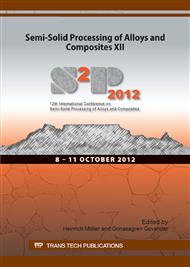p.398
p.404
p.410
p.415
p.422
p.428
p.433
p.441
p.447
Forced Convection Rheomoulding Process for Semisolid Slurry Preparation and Microstructure Evolution of 7075 Aluminum Alloy
Abstract:
A self-developed forced convection rheomoulding (FCR) machine for light alloy semisolid slurry preparation is introduced, which is high efficient, reliable and easy to maintain. Its core component contains a shearing system, a central temperature processing system and a discharge system. Flow characteristics and the parameter of FCR process affecting semisolid slurry organization are analysed. Taking 7075 aluminium alloy as experimental material, experimental results show that the FCR process could obtain semisolid microstructure with the small primary α-Al particles of nearly spherical and uniformly distributed. The melt of aluminium alloy involves complex convection mixing characteristics when flowing in FCR device. As the pouring temperature decreases, the primary particles become fine and homogeneous with the mean size diminished and the shape factor increased.
Info:
Periodical:
Pages:
422-427
Citation:
Online since:
October 2012
Authors:
Price:
Сopyright:
© 2013 Trans Tech Publications Ltd. All Rights Reserved
Share:
Citation:


